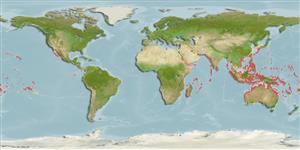Environment: milieu / climate zone / depth range / distribution range
Ecologia
marinhas demersal; intervalo de profundidade 4 - 20 m (Ref. 90102). Tropical
Indo-Pacific: from east Africa and Red Sea to western Australia, Taiwan and Ogasawara Is., Micronesia, the Hawaiian Is., the Cook Is., and the Pitcairn group.
Tamanho / Peso / Idade
Maturity: Lm ? range ? - ? cm
Max length : 3.5 cm TL macho/indeterminado; (Ref. 5467)
Espinhos dorsais (total) : 0; Raios dorsais (total) : 22 - 25; Espinhos anais: 0; Raios anais : 26 - 28. Body pale, with 8-12 narrow, short bars across dorsal surface (Ref. 5467). Dorsal saddles not reaching, even if present, a lateral band. Combined number of soft rays in dorsal and anal fins usually 44 to 51 (Ref 12874).
Benthic in surge-swept sand patches and shorelines (Ref. 1602, 58302). Found in sea bottoms with coarse sand and fine gravel 4-20 m deep (Ref. 90102). Occurs in small groups that bury themselves in coarse sand patches on reef corners subject to currents (Ref. 48636).
Ciclo de vida ou comportamento de acasalamento
Maturities | Reprodução | Spawnings | Egg(s) | Fecundities | Larvas
Nelson, J.S., 1986. Creediidae. p. 736-737. In M.M. Smith and P.C. Heemstra (eds.) Smiths' sea fishes. Springer-Verlag, Berlin. (Ref. 5467)
Status na Lista Vermelha da UICN (Ref. 130435)
Ameaça para os humanos
Harmless
Uso pelos humanos
Ferramentas
Relatórios especiais
Baixar XML
Fontes da internet
Estimates based on models
Preferred temperature (Ref.
123201): 24.2 - 29.3, mean 28.2 °C (based on 2840 cells).
Índice de diversidade filogenética (Ref.
82804): PD
50 = 0.5156 [Uniqueness, from 0.5 = low to 2.0 = high].
Bayesian length-weight: a=0.00389 (0.00180 - 0.00842), b=3.12 (2.94 - 3.30), in cm total length, based on all LWR estimates for this body shape (Ref.
93245).
Nível Trófico (Ref.
69278): 3.1 ±0.4 se; based on size and trophs of closest relatives
Fishing Vulnerability (Ref.
59153): Low vulnerability (10 of 100).
